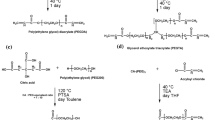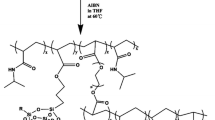Abstract
In this study, Poly(N-isopropylacrylamide) (PNIPAM) hydrogels were produced from N-isopropylacrylamide (NIPAM), at three different concentrations of crosslinker, N,N´-methylenebisacrylamide (BIS) (0.50%, 0.35%, and 0.25%) using two types of photoinitiator, a hydrophilic photoinitiator (Irgacure 2959) and a hydrophobic photoinitiator (Irgacure 651). When Irgacure 651 was used photopolymerization process was completed in 20 min compared to two hours with Irgacure 2959. However, the resultant hydrogels were opaque suggesting a heterogeneous structure, which in turn led to low compressive strength. Besides, when hydrogel solution was prepared with Irgacure 651 in water/ethanol mixture 0.25% crosslinker ratio was not sufficient to form a hydrogel. Irgacure 2959 produced homogenous transparent hydrogels with a higher degree of swelling. When the crosslinker ratio decreased swelling capacity increased, but hydrogels became weaker. The decrease in compressive strength was particularly high at the 0.25% crosslinker ratio. The crosslinker ratio or photoinitiator type did not have any significant effect on the phase transition temperature. On the other hand, hydrogel samples prepared with Irgacure 651 in water/ethanol mixture showed a quicker response to swelling and deswelling. In conclusion, in terms of morphology, swelling capacity, and compressive strength the best results were obtained with the crosslinker ratio of 0.35% and Irgacure 2959.












Similar content being viewed by others
Data availability
Data and materials supporting the work presented are available upon request.
References
Hatir PC, Capan OY (2019) Comparison of crosslinker types and initiation systems of thermoresponsive PNIPAM hydrogels. Düzce Üniversitesi Bilim ve Teknol Derg. https://doi.org/10.29130/dubited.544824
Sikdar P, Uddin MM, Dip TM et al (2021) Recent advances in the synthesis of smart hydrogels. Mater Adv 2
Ward MA, Georgiou TK (2011) Thermoresponsive polymers for biomedical applications. Polymers (Basel). https://doi.org/10.3390/polym3031215
Vihola H, Laukkanen A, Valtola L et al (2005) Cytotoxicity of thermosensitive polymers poly(N-isopropylacrylamide), poly(N-vinylcaprolactam) and amphiphilically modified poly(N-vinylcaprolactam). Biomaterials. https://doi.org/10.1016/j.biomaterials.2004.09.008
Xu X, Liu Y, Fu W et al (2020) Poly(N-isopropylacrylamide)-based thermoresponsive composite hydrogels for biomedical applications. Polymers (Basel) 12
He W, Ma Y, Gao X et al (2020) Application of poly(N-isopropylacrylamide) as thermosensitive smart materials. J Phys Conf Ser
Hsiue GH, Hsu SH, Yang CC et al (2002) Preparation of controlled release ophthalmic drops, for glaucoma therapy using thermosensitive poly-N-isopropylacrylamide. Biomaterials. https://doi.org/10.1016/S0142-9612(01)00127-2
Koca EI, Evrensel C, Cayli G, Hatir PC (2017) Effect of plant oil-based crosslinker on drug release behaviour of hydrogels. In 2017 Electric Electronics, Computer Science, Biomedical Engineerings’ Meeting (EBBT), pp 1–4. https://doi.org/10.1109/EBBT.2017.7956777
Klouda L, Mikos AG (2008) Thermoresponsive hydrogels in biomedical applications. Eur J Pharm Biopharm 68
da Silva RMP, Mano JF, Reis RL (2007) Smart thermoresponsive coatings and surfaces for tissue engineering: switching cell-material boundaries. Trends Biotechnol 25
Hu W, Wang Z, Xiao Y et al (2019) Advances in crosslinking strategies of biomedical hydrogels. Biomater Sci 7
Maitra J, Shukla VK (2014) Cross-linking in Hydrogels - A Review. Am J Polym Sci. https://doi.org/10.5923/j.ajps.20140402.01
Akhtar MF, Hanif M, Ranjha NM (2016) Methods of synthesis of hydrogels… A review. Saudi Pharm J 24(5):554–559
Nicol E (2021) Photopolymerized porous hydrogels. Biomacromolecules 22
Hamid ZAA, Lim KW (2016) Evaluation of UV-crosslinked poly(ethylene glycol) diacrylate/poly(dimethylsiloxane) dimethacrylate hydrogel: properties for tissue engineering application. Procedia Chem. https://doi.org/10.1016/j.proche.2016.03.032
Kurečič M, Majda SS, Karin SK (2012) Uv polymerization of poly(N-isopropylacrylamide) hydrogel. Mater Tehnol 46
Yagci Y, Jockusch S, Turro NJ (2010) Photoinitiated polymerization: Advances, challenges, and opportunities. Macromolecules 43
Singh D, Kuckling D, Choudhary V et al (2006) Synthesis and characterization of poly(N-isopropylacrylamide) films by photopolymerization. Polym Adv Technol. https://doi.org/10.1002/pat.713
Kunio I, Takeshi E (2010) A review of the development of radical photopolymerization initiators used for designing light-curing dental adhesives and resin composites. Dent Mater J 29
Lago MA, Rodríguez-Bernaldo de Quirós A, Sendón R et al (2015) Photoinitiators: a food safety review. Food Addit Contam Part A Chem Anal Control Expo Risk Assess. https://doi.org/10.1080/19440049.2015.1014866
Nguyen KT, West JL (2002) Photopolymerizable hydrogels for tissue engineering applications. Biomaterials. https://doi.org/10.1016/S0142-9612(02)00175-8
Tomal W, Ortyl J (2020) Water-soluble photoinitiators in biomedical applications. Polymers (Basel) 12
Lee C, O’Connell CD, Onofrillo C et al (2020) Human articular cartilage repair: Sources and detection of cytotoxicity and genotoxicity in photo-crosslinkable hydrogel bioscaffolds. Stem Cells Transl Med 9
He Y, Yu R, Li X et al (2021) Digital light processing 4D printing of transparent, strong, highly conductive hydrogels. ACS Appl Mater Interfaces. https://doi.org/10.1021/acsami.1c08438
Lin CC, Sawicki SM, Metters AT (2008) Free-radical-mediated protein inactivation and recovery during protein photoencapsulation. Biomacromol. https://doi.org/10.1021/bm700782c
Zhang XZ, Yang YY, Chung TS (2002) Effect of mixed solvents on characteristics of poly(N-isopropylacrylamide) gels. Langmuir. https://doi.org/10.1021/la011410j
Rezaul Karim M, Harun-Ur-Rashid M, Bin IA (2020) Highly stretchable hydrogel using vinyl modified narrow dispersed silica particles as cross-linker. ChemistrySelect. https://doi.org/10.1002/slct.202003044
Acknowledgements
The authors would like to express appreciation for the support of the Scientific and Technological Research Council of Turkey (TÜBİTAK) [Project Number =119M355].
Author information
Authors and Affiliations
Corresponding author
Ethics declarations
Conflict of interest
The authors declare no competing financial interest.
Additional information
Publisher's Note
Springer Nature remains neutral with regard to jurisdictional claims in published maps and institutional affiliations.
Rights and permissions
Springer Nature or its licensor (e.g. a society or other partner) holds exclusive rights to this article under a publishing agreement with the author(s) or other rightsholder(s); author self-archiving of the accepted manuscript version of this article is solely governed by the terms of such publishing agreement and applicable law.
About this article
Cite this article
Oral, N., Basal, G. The effects of crosslinker ratio and photoinitiator type on the properties of pnipam hydrogel. J Polym Res 30, 34 (2023). https://doi.org/10.1007/s10965-022-03419-2
Received:
Accepted:
Published:
DOI: https://doi.org/10.1007/s10965-022-03419-2




